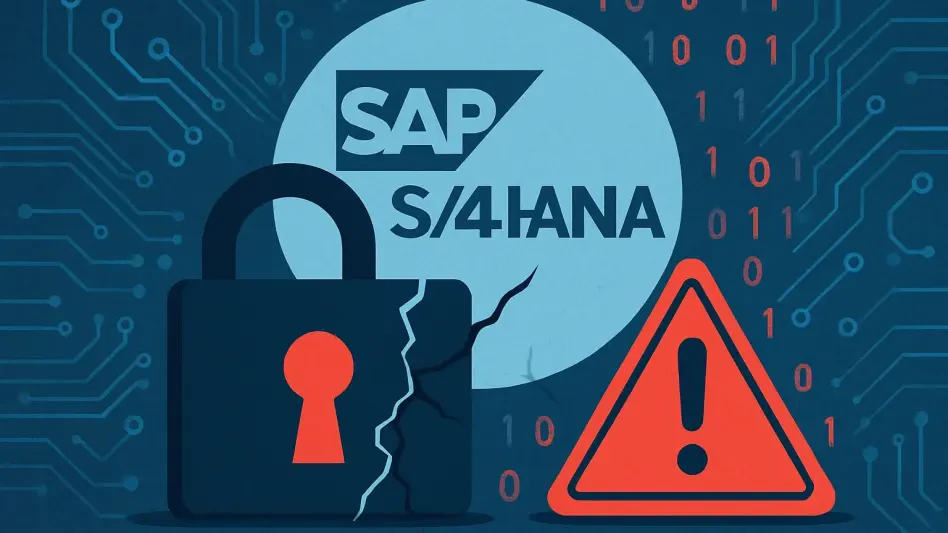In a deeply alarming development for enterprises worldwide, a critical vulnerability in SAP S/4HANA, identified as CVE-2025-42957 with a near-perfect CVSS score of 9.9, has been confirmed to be under active exploitation, posing an immediate and severe risk to organizations. This high-severity flaw enables attackers with minimal access privileges to execute remote code injection, potentially leading to a complete system takeover. Organizations relying on SAP S/4HANA, whether on-premise or in private cloud environments, face an urgent threat to their operational integrity and data security. The ease of exploitation, requiring only basic credentials and no user interaction, underscores the gravity of this issue. As threat actors target this vulnerability to gain unauthorized access and disrupt critical business processes, immediate action is essential. This article delves into the nature of the flaw, its potential impact, and the necessary steps for mitigation to protect enterprise systems from devastating consequences.
1. Understanding the Vulnerability and Its Discovery
A significant security flaw in SAP S/4HANA was uncovered during routine testing by security researchers on June 27 of this year. Tracked as CVE-2025-42957, this vulnerability affects all releases of the software in on-premise and private cloud setups. The flaw resides in specific Remote Function Call (RFC) modules, allowing a low-privileged user with minimal access to inject malicious code into the SAP application layer. What makes this particularly dangerous is the simplicity of the attack vector: all that is needed is a valid SAP user account and access to the vulnerable module, coupled with the S_DMIS authorization object set to activity 02. No additional tactics, such as phishing or social engineering, are required for exploitation. After the discovery, the issue was responsibly disclosed to SAP, prompting the vendor to release critical fixes during the August Patch Day. However, the window between discovery and patching has already seen exploitation attempts, highlighting the speed at which attackers can weaponize such flaws.
The implications of this vulnerability are profound for organizations that fail to act swiftly. Once exploited, attackers can execute arbitrary ABAP code, manipulate or delete database records, and even create administrative accounts with unrestricted SAP_ALL privileges. Beyond data theft, which includes downloading password hashes for all accounts, adversaries can disrupt business operations, deploy ransomware, or tamper with sensitive financial and customer data. The network-based nature of this exploit facilitates rapid privilege escalation, transforming basic access into full system control in a matter of moments. Security experts have noted that while a large-scale global campaign has not yet been detected, targeted attacks are already underway. The visibility of ABAP code further complicates the situation, as reverse-engineering the provided patches becomes a straightforward task for skilled threat actors, enabling them to craft reliable exploits with alarming efficiency.
2. Impact on Enterprise Operations
The potential fallout from this SAP S/4HANA vulnerability poses an existential threat to enterprises that depend on the platform for critical business functions. A successful exploit can lead to unauthorized access to sensitive data, including financial records and customer information, which could result in significant financial losses and legal repercussions. Beyond data breaches, the ability of attackers to disrupt or disable key processes can halt operations entirely, causing downtime that impacts revenue and customer trust. In severe cases, the deployment of ransomware through this vulnerability could lock organizations out of their own systems, demanding substantial payments for restoration. The reputational damage from such incidents often proves even more costly, as stakeholders and clients lose confidence in the affected company’s ability to safeguard critical assets and maintain operational stability in a competitive market.
Moreover, the ease of exploitation amplifies the risk for organizations with large user bases or complex SAP environments. Even a single compromised low-privileged account can serve as a gateway for attackers to gain complete control over the system. This scenario is particularly concerning for industries such as manufacturing, finance, and retail, where SAP S/4HANA is integral to managing supply chains, transactions, and inventory. The creation of unauthorized administrative accounts further exacerbates the threat, as attackers can establish persistent access, making detection and remediation more challenging. Security teams must recognize that the consequences extend beyond immediate data loss, potentially leading to long-term operational disruptions. As targeted attacks have already been confirmed, enterprises must prioritize protective measures to prevent cascading failures across their digital infrastructure.
3. Urgent Mitigation Strategies
To counter the risks posed by CVE-2025-42957, organizations must implement a multi-layered defense strategy without delay. The first step involves applying the security patches released by SAP during the August Patch Day, specifically Security Notes 3627998 and 3633838, which address the vulnerable RFC modules. Beyond patching, hardening authorizations is critical—reviewing and restricting the usage of the S_DMIS object and limiting RFCs to trusted sources can significantly reduce exposure. Network segmentation also plays a vital role; enforcing strict boundaries between SAP application servers and general user networks minimizes the attack surface. Additionally, deploying SAP UCON for refined access control policies can further secure the environment against unauthorized access attempts, ensuring that even basic accounts cannot be exploited for malicious purposes.
Continuous monitoring and robust backup practices form the backbone of a resilient response to this threat. Enterprises should actively monitor system logs for unusual RFC request patterns or the creation of unauthorized administrative accounts, enabling early detection of potential exploits. Real-time alerting mechanisms can provide critical insights into suspicious activities, allowing security teams to respond before significant damage occurs. Simultaneously, maintaining up-to-date, encrypted backups of SAP configurations and databases ensures swift recovery in the event of an incident. Organizations leveraging advanced security platforms may benefit from enhanced detection and blocking capabilities tailored to this specific vulnerability. By combining timely patching, rigorous authorization management, and proactive monitoring, enterprises can safeguard their SAP landscapes against the severe risks of fraud, data loss, and operational disruption.
4. Reflecting on Lessons Learned
Looking back, the emergence of CVE-2025-42957 served as a stark reminder of the vulnerabilities inherent in even the most robust enterprise systems. The rapid transition from discovery to active exploitation underscored how quickly threat actors could capitalize on critical flaws, often outpacing the response times of many organizations. Targeted attacks, though limited in scope at the time, revealed the precision with which adversaries could strike, exploiting minimal access to achieve devastating outcomes. This incident also highlighted the critical role of responsible disclosure and vendor collaboration, as the timely release of patches by SAP provided a lifeline for affected enterprises. Yet, the reality of reverse-engineered exploits emphasized that patches alone were insufficient without comprehensive security practices.
Moving forward, enterprises were urged to adopt a proactive stance by integrating regular security assessments and patch management into their operational frameworks. Strengthening access controls and network segmentation emerged as non-negotiable steps to prevent similar incidents. Investing in continuous monitoring tools and incident response plans became a priority to detect and mitigate threats in real time. Ultimately, this event reinforced the need for a cultural shift within organizations, prioritizing cybersecurity as a core component of business strategy. By learning from these challenges, companies could better prepare for future vulnerabilities, ensuring resilience against evolving threats in an increasingly complex digital landscape.








